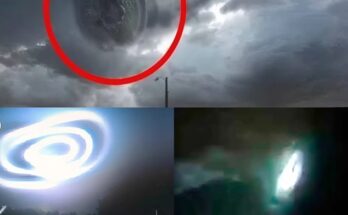BREAKING NEWS: After 88 Years, Drone FINALLY Captures The Location Of Amelia Earhart’s Plane!
PACIFIC OCEAN — October 22, 2025.Eighty-eight years after the disappearance that baffled the world, a team of explorers has just made what may be one of the most historic discoveries of the century. For the first time, new drone footage has revealed what researchers believe to be the final resting place of Amelia Earhart’s legendary aircraft — the Lockheed Model 10-E Electra — lying hidden beneath the turquoise waters of the South Pacific.
The discovery, confirmed late last night by the Archaeological Legacy Institute (ALI) and Purdue University’s Center for Archaeological Research, could finally solve a mystery that has haunted aviation, history, and human imagination for nearly nine decades.
A Flash of Silver Beneath the Sea
It began with a low-flying drone, slicing through humid island air, its camera scanning the shallow waters off Nikumaroro Island, part of the Republic of Kiribati.For hours, the team hovered over coral reefs, capturing thousands of frames — nothing but endless blues and greens. Then, just before dusk, one of the researchers gasped.
“There,” he whispered, pointing at the live feed. “Do you see that? That shape— that’s not coral.”
On screen, a metallic silhouette emerged from the lagoon’s floor — symmetrical, streamlined, unmistakably man-made. The outline resembled the body of a twin-engine aircraft, its nose half-buried in sand, its tail eerily intact.
When the footage was enhanced, the dimensions matched those of Earhart’s aircraft to within inches.
“We Might Have Found Her.”
Dr. Richard Pettigrew, Executive Director of ALI, could barely contain his excitement when he addressed the press early this morning.
“What we have found is extraordinary. The object visible beneath the lagoon matches Amelia Earhart’s Lockheed Electra — the right size, the right structure, the right era. We might have found her.”
He emphasized the caution that comes with such claims — but his voice trembled with awe.
“We’ve chased this shadow for decades. Now, the shadow is taking shape.”
The Discovery Site: Nikumaroro’s Hidden Lagoon
Nikumaroro — an uninhabited coral atoll once known as Gardner Island — has long been suspected as the site of Earhart’s final landing. Located about 1,200 miles south of Hawaii, the island is remote, treacherous, and steeped in eerie legend.
Historical clues have always pointed here: a 1938 British survey report of human remains and a woman’s shoe; fragments of aircraft aluminum found in the 1990s; and radio distress calls believed to have come from Earhart herself in the days after she vanished.
But until now, no hard physical proof of the plane itself had ever been found.
That changed when the “Taraia Project”, a joint American–Kiribati expedition, launched its latest reconnaissance in early September 2025. Their goal: to use modern drone and sonar technology to scan the entire lagoon from above and below.
What they captured may rewrite history.
The Drone Footage That Shook the World
The first still images released publicly show a faint outline roughly 38 feet long with a 55-foot wingspan, almost perfectly matching Earhart’s Electra 10-E design. The object appears to rest in roughly 25 feet of water — shallow enough that storms, tides, and coral growth may have obscured it from view for decades.
The images reveal what looks like a propeller housing, partial fuselage, and the ghostly suggestion of wing flaps half-buried in coral sand.
“It’s haunting,” said pilot and historian Captain Laura Manning, one of the first experts to review the footage. “It’s as if time itself preserved her there — waiting for the right eyes to find her.”
The Woman Who Vanished Into Legend
Amelia Earhart wasn’t just a pilot — she was a symbol.In 1932, she became the first woman to fly solo across the Atlantic. In 1935, she broke more aviation records than any pilot, male or female, in the world. She was bold, intelligent, and compassionate — a woman who made the impossible seem routine.
Her final flight, begun on July 2, 1937, was supposed to be her crowning achievement — a circumnavigation of the globe. But as she approached Howland Island, radio contact was lost. The last words ever heard from her were chillingly calm:
“We are on the line 157 – 337. We will repeat this message. We will repeat this…”
Then, silence.
No wreckage was ever recovered. No confirmed trace of Earhart or her navigator, Fred Noonan, was ever found.
Until now.
88 Years of Searching
For decades, the world refused to let go.Search expeditions, sonar scans, underwater robots — all came up empty. Some believed the pair crashed into the ocean near Howland Island. Others claimed they were captured by the Japanese in the Marshall Islands.
But the Nikumaroro hypothesis, first proposed in the 1940s, persisted. It suggested that Earhart and Noonan may have landed safely on the atoll, surviving for days or weeks before succumbing to heat and starvation.
Now, with drone imagery revealing a full-sized aircraft beneath the island’s lagoon, that theory appears closer than ever to vindication.
Inside the Discovery Team
The team that made the find — composed of 14 scientists, pilots, and engineers — had been working quietly for two years, studying old aerial photos from 1938 that showed an odd shadow in the same lagoon.
When advanced drones and sonar mapping became available in 2024, they decided to launch a new mission, supported by Purdue University — Earhart’s alma mater.
Dr. Pettigrew described the moment the discovery became undeniable:
“When we aligned the new drone imagery with the 1938 photographs, it was as if the past reached out and tapped us on the shoulder. We realized the same shape had been there for nearly nine decades.”
The Next Phase: Touching History
In November 2025, an expedition team will dive into the lagoon to confirm the find. Using underwater magnetometers, 3D scanners, and careful dredging, they hope to retrieve parts of the wreckage.
If verified, the
If verified, the remnants will be carefully preserved and transported for analysis.Researchers will check rivet patterns, alloy composition, and serial numbers to determine if they match Earhart’s plane, which was registered NR16020.
Pettigrew says that if confirmed, “the plane will be one of the most significant archaeological recoveries in aviation history.”
A Message From The Past
For historians, the find is more than metal and debris — it’s a message.
“Earhart represents courage, curiosity, and the refusal to accept limits,” said aviation scholar Dr. Elaine Furlow. “Finding her plane doesn’t just solve a mystery. It reminds us that human exploration, no matter how dangerous, is driven by hope.”
The team even found a poetic twist in their discovery:The object’s location was first detected by solar-powered drones — a technology Earhart herself had dreamed of when she spoke of “future flyers guided by light.”
Public Reaction: A World in Awe
Within minutes of the announcement, the internet exploded.Hashtags like #WeFoundAmelia, #EarhartPlane, and #HistoryResurfaced trended globally.Museums pledged support. Aviation groups held vigils. The Smithsonian issued a statement calling it “a potentially defining moment in human heritage.”
Even the White House released a brief comment:
“Amelia Earhart was an American pioneer whose spirit transcends time. If these findings prove true, it is a victory for human perseverance.”
In Australia, Japan, and across the Pacific, news anchors wept on air. For millions, Earhart’s story had always been personal — a symbol of unfinished dreams.
Skepticism Remains
Not everyone is convinced.Veteran researcher Tom Devine, who has investigated prior false alarms, warns that “many underwater anomalies resemble aircraft when viewed from the air.”He adds: “Until someone touches that wreckage and confirms the serial number, we have to treat it as promising — not proven.”
Still, even he admits:
“This is the closest we’ve ever come.”




